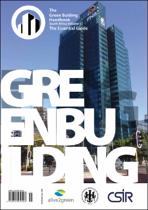JavaScript is disabled for your browser. Some features of this site may not work without it.
- ResearchSpace
- →
- Research Publications/Outputs
- →
- Books
- →
- View Item
| dc.contributor.author |
Van Wyk, Llewellyn V

|
|
| dc.date.accessioned | 2018-04-10T13:00:56Z | |
| dc.date.available | 2018-04-10T13:00:56Z | |
| dc.date.issued | 2017-12 | |
| dc.identifier.citation | Van Wyk, L.V. (ed). 2017. The Green Building Handbook South Africa Volume 11: The Essential Guide. Cape Town: Alive2green | en_US |
| dc.identifier.isbn | 0620452404 | |
| dc.identifier.isbn | 9780620452403 | |
| dc.identifier.uri | https://issuu.com/alive2green/docs/gbh11_web | |
| dc.identifier.uri | http://hdl.handle.net/10204/10170 | |
| dc.description | The Green Building Handbook South Africa Volume 11: The Essential Guide | en_US |
| dc.description.abstract | Over the years the Green Building Handbook has increased its scope beyond the confines of "green building" as typically defined in green building rating systems. This is largely due to the recognition that building green, or more accurately, building sustainably, cannot occur only at the scale of an individual building. Ultimately, it is at the human settlement scale, with all of its complexity, that sustainability is required. Buildings, or more precisely their occupants, are dependent on numerous inputs for its ongoing operation. Generally those inputs occur at a city-scale, and include water, sanitation, and energy. Given the current water shortage in Cape Town it would be amiss of this publication not to respond to this challenge, especially as the climate change impact projections indicate an increasingly hotter and drier country. Two chapter's present alternative solutions to this crisis, arguing that just as renewable energy promised alternative solutions to energy shortages, the adoption of renewable water as a similar concept offers alternative solutions to the water shortage. Transport has been a feature of green building rating tools since their inception: a chapter evaluates the pros and cons of the Green Building Council of South Africa's commuting calculator using ten Green Star rated buildings in Gauteng Province, with a focus on mass transport ratings. The evaluation is necessary, among other things, to guide decision makers on the implication of the star ratings on general transport planning. | en_US |
| dc.language.iso | en | en_US |
| dc.publisher | Alive2green | en_US |
| dc.relation.ispartofseries | Worklist;20701 | |
| dc.subject | Green buildings | en_US |
| dc.subject | Climate change | en_US |
| dc.title | The Green Building Handbook South Africa Volume 11: The Essential Guide | en_US |
| dc.type | Book | en_US |
| dc.identifier.apacitation | Van Wyk, L. V. (2017). <i>The Green Building Handbook South Africa Volume 11: The Essential Guide</i>. Alive2green. http://hdl.handle.net/10204/10170 | en_ZA |
| dc.identifier.chicagocitation | Van Wyk, Llewellyn V. <i>The Green Building Handbook South Africa Volume 11: The Essential Guide</i>. n.p.: Alive2green. 2017. http://hdl.handle.net/10204/10170. | en_ZA |
| dc.identifier.vancouvercitation | Van Wyk LV. The Green Building Handbook South Africa Volume 11: The Essential Guide. [place unknown]: Alive2green; 2017.http://hdl.handle.net/10204/10170 | en_ZA |
| dc.identifier.ris | TY - Book AU - Van Wyk, Llewellyn V AB - Over the years the Green Building Handbook has increased its scope beyond the confines of "green building" as typically defined in green building rating systems. This is largely due to the recognition that building green, or more accurately, building sustainably, cannot occur only at the scale of an individual building. Ultimately, it is at the human settlement scale, with all of its complexity, that sustainability is required. Buildings, or more precisely their occupants, are dependent on numerous inputs for its ongoing operation. Generally those inputs occur at a city-scale, and include water, sanitation, and energy. Given the current water shortage in Cape Town it would be amiss of this publication not to respond to this challenge, especially as the climate change impact projections indicate an increasingly hotter and drier country. Two chapter's present alternative solutions to this crisis, arguing that just as renewable energy promised alternative solutions to energy shortages, the adoption of renewable water as a similar concept offers alternative solutions to the water shortage. Transport has been a feature of green building rating tools since their inception: a chapter evaluates the pros and cons of the Green Building Council of South Africa's commuting calculator using ten Green Star rated buildings in Gauteng Province, with a focus on mass transport ratings. The evaluation is necessary, among other things, to guide decision makers on the implication of the star ratings on general transport planning. DA - 2017-12 DB - ResearchSpace DP - CSIR KW - Green buildings KW - Climate change LK - https://researchspace.csir.co.za PY - 2017 SM - 0620452404 SM - 9780620452403 T1 - The Green Building Handbook South Africa Volume 11: The Essential Guide TI - The Green Building Handbook South Africa Volume 11: The Essential Guide UR - http://hdl.handle.net/10204/10170 ER - | en_ZA |






